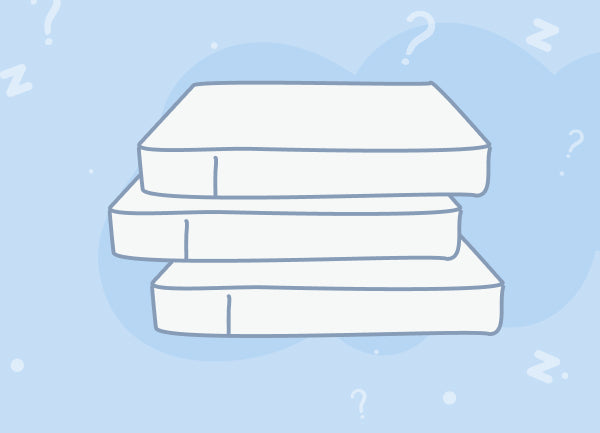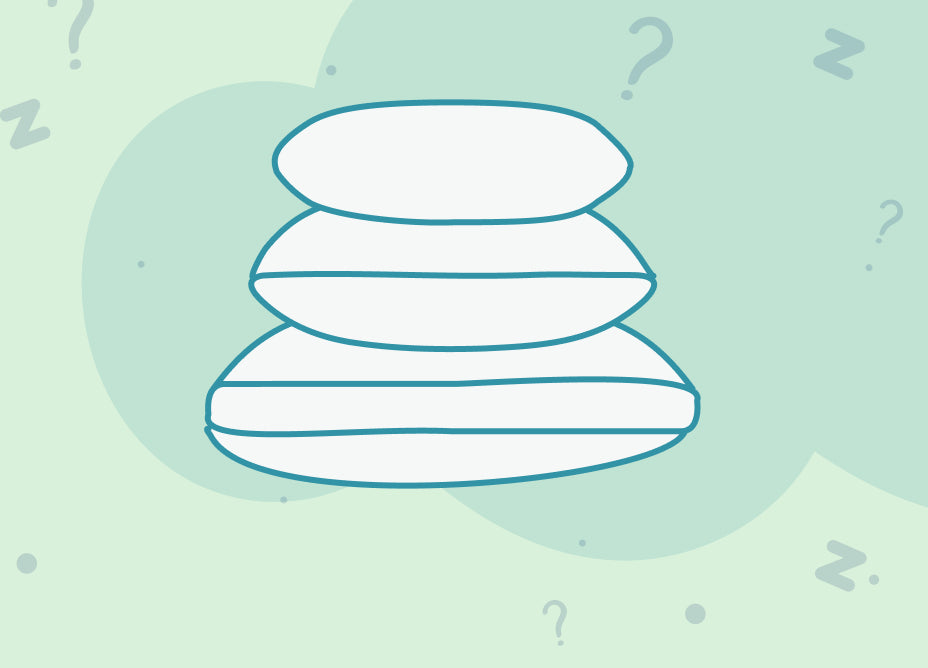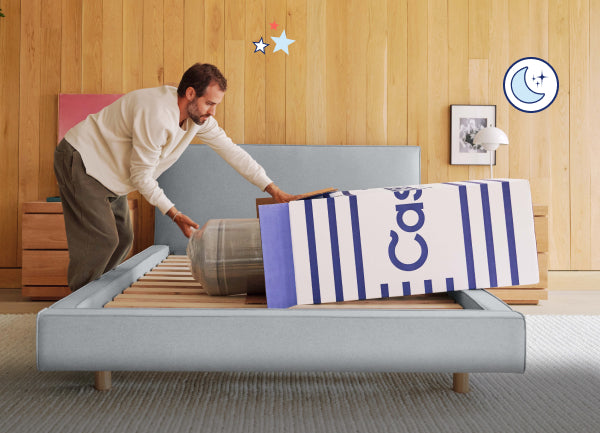A firmer mattress isn't always best—but there's also such a thing as too soft. It depends on your sleeping position, body size, and whether you have pain or alignment issues.
An achy back can make it hard to get comfortable in bed and lead to poor-quality sleep, like waking up frequently or not getting enough deep sleep. Though proper support from your mattress can help with spinal alignment and pressure-point relief, exactly how firm it should be is up for debate.1
Is a firm mattress better for your back? Mattress firmness doesmatter—there's a scale for it and everything—but this doesn't mean the firmest mattress is the best mattress.
We'll break it all down below with expert insight from an ergonomist, including what firmness level is ideal for each sleeping position, what to look for if you have back pain or alignment issues, and what you can do (besides upgrade your mattress) for better back support while sleeping.
Why Mattress Firmness Isn't One-Size-Fits-All
Research shows that medium-firm mattresses, like Casper’s The One, work well for many people, offering an ideal balance of pressure relief, alignment support, and overall comfort to promote high-quality shut-eye.1,2
Having said that, mattress firmness isn't a one-size-fits-all situation. A number of factors, from body weight to sleeping position to personal preferences, can affect how a mattress feels and functions.
And if you're dealing with back pain, the location of the pain matters too. That's why some mattresses (like several from Casper) have zoned support systems with firmness and pressure relief exactly where you need it.
What Does “Firm” Really Mean?
Ranging from very firm to very soft, mattress firmness is often rated on a scale from 1 to 10. With Casper's mattress firmness scale, 1 is the firmest and 10 is the softest.
Most mattresses on the market are medium (about a 5 on the scale) or medium-firm (more like a 3 or 4). These mid-range firmness levels are a good choice for lots of adult sleepers, even those with back stiffness or pain.3But again, it depends on the person's specific needs and sleeping style.
Why Too Firm Can Be a Problem
A slightly firmer-than-average mattress (often called medium-firm) can help reduce pack pain. But a mattress that's too stiff could actually exacerbate the issue. An extra-firm design might make it harder for your lower back to touch the surface when lying on your back, which could mess with your spinal alignment.4
A stiffer sleeping surface might also be uncomfortable on the hips and shoulders when sleeping on your side.
Why Too Soft Can Also Cause Pain
An ultra-soft bed might conjure an image of sleeping on a cloud. However, while plush mattresses can work for some people, one that's too soft might be bad news for your back.
An ultra-plush or pillowtop mattress can make your hips sink down when sleeping on your side. This can create pressure on your spine and strain in your back.4If you tend to snooze on your stomach, a soft mattress could cause your lower back to arch, possibly leading to strain and misalignment in your spine.5

Finding the Right Mattress for Back Support
Your sleeping position, body weight, and particular ailments can provide clues for what mattress firmness is best.
Start With Your Sleep Position
Here's what type of mattress is ideal for each sleeping position:
- Back sleepers– A medium-firm mattress that's supportive but not too stiff is a good choice for back sleepers.
- Side sleepers– Side sleepers may want something slightly softer—but not too soft. A medium mattress, possibly with a plush topper, can alleviate pressure on the hips and shoulders without sinking the body down.
- Stomach sleepers– Stomach sleepers should consider a firmer mattress to prevent their lower back from arching while they doze.
Ergonomist’s Note:
“For side sleepers, a mattress that is too firm can prevent the shoulders from sinking into the mattress, resulting in a misalignment between the upper and lower portions of the spine. On the other hand, if the mattress is too soft, the hips will sink in too far compared to the torso, again compromising spinal alignment.”
- Jonathan Eilenberg, Casper’s Certified Professional Ergonomist
Consider Your Body Weight
Heavier bodies often need the extra support a firmer mattress provides. This can encourage proper spinal alignment and minimize back pain. On the other hand, lighter-weight sleepers might find that stiffer mattresses strain their hips and softer designs offer more pressure relief.6
Prioritize Pressure Relief and Spinal Alignment
Anyone dealing with back pain is wise to prioritize pressure relief and spinal alignment when choosing a mattress. The best option might be a design with zoned support—softer at the shoulders, firmer at the lower back, midsection, and hips, and softer from the legs down.7
Responsive memory foam mattresses and hybrid mattress models with foam and pocketed coils can be excellent choices for people with back issues.
Ergonomist’s Note:
“Most research agrees that a "medium-firm" mattress is the best option for a wide range of the population and can help alleviate and prevent back pain. This is a good general recommendation but does not account for body dimensions such as weight, shoulder breadth, hip breadth, and height. The best way to find a mattress that fits you is to try it in person for at least 20 minutes to see how the mattress supports your body. Pay attention to any pressure points and to the position and angle of your shoulders and hips.”
- Jonathan Eilenberg, Casper’s Certified Professional Ergonomist
Other Ways to Improve Back Pain While Sleeping
A good mattress goes a long way in encouraging quality sleep and keeping back pain at bay. But there are a few other things you can try.
Add a Mattress Topper to Adjust Firmness
A comfy mattress topper can add a plush layer, responsiveness, and pressure relief. If your current mattress is too soft, a firm topper can elevate the support.
Use Pillows for Alignment
Sleeping with a body pillow or even just placing a standard bed pillow between your knees can reduce strain on your lower back and help realign your spine. For back sleepers, special neck and lumbar-support pillows can neutralize the spine, which might help prevent back pain.7

Try an Adjustable Base
An adjustable bed frame with zero-gravity positions and elevation for your feet might help alleviate discomfort in your back and reduce pressure points throughout your body.
Casper's Got Your Back
Is a firm mattress better for your back? Firmness undoubtedly matters with mattresses, but the idea that firmer is always better is a myth. It really depends on the person's unique needs, preferences, and sleeping style. Medium and medium-firm mattresses work for many people, but some might need something slightly softer or firmer.
On a similar note, the most expensive mattress isn't always best—nor does it mean more support. Investing in a high-quality mattress with proper support is often worth it, but you definitely don't have to spend a fortune.
Casper has mattresses for every type of sleeper, including hybrid models with zoned support. If you want to tackle a good night's rest from all angles, our bed sheets and bed pillows will help the cause.
Sources:
- Journal of Orthopaedics and Traumatology. What type of mattress should be chosen to avoid back pain and improve sleep quality? Review of the literature. https://jorthoptraumatol.springeropen.com/articles/10.1186/s10195-021-00616-5
- Sleep Health. Effect of different mattress designs on promoting sleep quality, pain reduction, and spinal alignment in adults with or without back pain; systematic review of controlled trials. https://www.sciencedirect.com/science/article/abs/pii/S2352721815001400
- The Lancet. Effect of firmness of mattress on chronic non-specific low-back pain: randomised, double-blind, controlled, multicentre trial. https://www.thelancet.com/journals/lancet/article/PIIS0140-6736(03)14792-7/abstract
- Biology (Basel). The Influence of Mattress Stiffness on Spinal Curvature and Intervertebral Disc Stress—An Experimental and Computational Study. https://pmc.ncbi.nlm.nih.gov/articles/PMC9311775/
- Sleep Foundation. Sleeping On Your Stomach – Is it Bad for You?. https://www.sleepfoundation.org/sleeping-positions/sleeping-on-stomach
- University of Central Lancashire. Determining the ideal mattress firmness based on anthropometric measurements. https://clok.uclan.ac.uk/31171/
- Sleep Science and Practice. Effects of mattress support on sleeping position and low-back pain. https://sleep.biomedcentral.com/articles/10.1186/s41606-022-00073-x
- Applied Ergonomics. Biomechanical evaluation of four different mattresses. https://www.sciencedirect.com/science/article/abs/pii/S0003687005001171?via%3Dihub
- Harvard Health Publishing. What type of mattress is best for people with low back pain?. https://www.health.harvard.edu/pain/what-type-of-mattress-is-best-for-people-with-low-back-pain
- National Center for Biotechnology Information (NCBI). Therapeutic Mattresses for Chronic Pain. https://www.ncbi.nlm.nih.gov/books/NBK599022/










